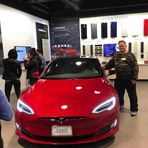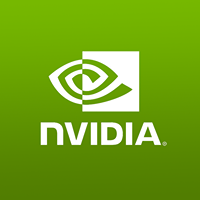Nvidia's Road to a Billion-Dollar Future: The Rise of Driver-Assistance Technology
February 28, 2025, 11:38 pm

Location: United States, Texas, Austin
Employees: 10001+
Founded date: 2003
Total raised: $3.86B
Nvidia is revving its engines. The company’s automotive segment is surging, fueled by a growing demand for driver-assist technology. In the fourth quarter of the 2025 fiscal year, Nvidia’s automotive and robotics revenue soared to a record $570 million. That’s more than double what it was a year ago. This rapid growth signals a shift in the tech landscape.
Driver-assist technology is the new gold rush. Nvidia is positioning itself as a key player in this space. The company’s products are not just components; they are the brains behind the wheel. With the rise of autonomous vehicles, Nvidia is tapping into a market that could become its next billion-dollar business.
The automotive segment now accounts for a mere 1.45% of Nvidia’s total revenue. But that number is set to grow. Analysts predict that as more companies invest in autonomous driving, Nvidia’s share of the pie will expand. Companies like Waymo and Tesla are leading the charge, and Nvidia is in the driver’s seat.
The demand for self-driving platforms is on the rise. Nvidia’s technology powers advanced driver-assistance systems (ADAS) and robotics. This growth is not just a flash in the pan. It’s a long-term trend. The automotive industry is evolving, and Nvidia is at the forefront.
The company’s CEO envisions a future where every car on the road is robotic. Imagine a world where vehicles collect data and learn from their surroundings. Nvidia’s AI systems will refine this data, making driving safer and more efficient. The potential is enormous.
Nvidia’s success is not just about numbers. It’s about innovation. The company’s Blackwell artificial intelligence chip is a game-changer. Big Tech is pouring billions into this technology. It’s a testament to Nvidia’s pivotal role in the AI revolution.
But the road ahead is not without bumps. Consumer confidence in the U.S. economy is shaky. Surveys show rising concerns about inflation and economic stability. An inverted yield curve has raised alarms about a potential recession. While Nvidia is thriving, the broader economic landscape is uncertain.
Despite these challenges, Nvidia’s earnings have exceeded expectations. The company reported a net income of $22.09 billion in the fourth quarter, an 80% increase from the previous year. Revenue rose 78%. This performance is impressive, but the stock market reacted cautiously. Shares fell 1.5% in after-hours trading.
Investors are watching closely. Nvidia’s influence on the stock market is significant. Its earnings can sway market trends. The tech giant’s performance is a bellwether for the industry. As Nvidia goes, so goes the market.
The automotive and robotics segment is gaining traction. Analysts predict continued growth. Companies in China, like BYD and Nio, are already using Nvidia’s driver-assist chip systems. This international reach adds another layer of potential.
The future of robotics is also bright. As more companies develop humanoid robots, the demand for Nvidia chips will increase. The tech landscape is changing, and Nvidia is adapting. The company is not just a chipmaker; it’s a pioneer in the AI and robotics sectors.
However, the competition is fierce. Other companies are also vying for a piece of the autonomous vehicle market. Nvidia must stay ahead of the curve. Innovation will be key. The company’s ability to deliver cutting-edge technology will determine its success.
The automotive industry is on the brink of transformation. The shift towards electric and autonomous vehicles is accelerating. Governments are implementing policies to support this transition. India, for example, is eager to attract Tesla by lowering import duties on electric vehicles. This global push for EVs creates opportunities for Nvidia.
As the market evolves, Nvidia’s role will become even more critical. The company’s technology will be integral to the future of transportation. The potential for growth is vast. Nvidia is not just riding the wave; it’s shaping the tide.
In conclusion, Nvidia’s automotive segment is poised for explosive growth. The demand for driver-assist technology is rising, and the company is well-positioned to capitalize on this trend. While economic uncertainties loom, Nvidia’s innovation and strategic positioning will likely drive its success. The road ahead is filled with promise, and Nvidia is ready to accelerate into the future.
Driver-assist technology is the new gold rush. Nvidia is positioning itself as a key player in this space. The company’s products are not just components; they are the brains behind the wheel. With the rise of autonomous vehicles, Nvidia is tapping into a market that could become its next billion-dollar business.
The automotive segment now accounts for a mere 1.45% of Nvidia’s total revenue. But that number is set to grow. Analysts predict that as more companies invest in autonomous driving, Nvidia’s share of the pie will expand. Companies like Waymo and Tesla are leading the charge, and Nvidia is in the driver’s seat.
The demand for self-driving platforms is on the rise. Nvidia’s technology powers advanced driver-assistance systems (ADAS) and robotics. This growth is not just a flash in the pan. It’s a long-term trend. The automotive industry is evolving, and Nvidia is at the forefront.
The company’s CEO envisions a future where every car on the road is robotic. Imagine a world where vehicles collect data and learn from their surroundings. Nvidia’s AI systems will refine this data, making driving safer and more efficient. The potential is enormous.
Nvidia’s success is not just about numbers. It’s about innovation. The company’s Blackwell artificial intelligence chip is a game-changer. Big Tech is pouring billions into this technology. It’s a testament to Nvidia’s pivotal role in the AI revolution.
But the road ahead is not without bumps. Consumer confidence in the U.S. economy is shaky. Surveys show rising concerns about inflation and economic stability. An inverted yield curve has raised alarms about a potential recession. While Nvidia is thriving, the broader economic landscape is uncertain.
Despite these challenges, Nvidia’s earnings have exceeded expectations. The company reported a net income of $22.09 billion in the fourth quarter, an 80% increase from the previous year. Revenue rose 78%. This performance is impressive, but the stock market reacted cautiously. Shares fell 1.5% in after-hours trading.
Investors are watching closely. Nvidia’s influence on the stock market is significant. Its earnings can sway market trends. The tech giant’s performance is a bellwether for the industry. As Nvidia goes, so goes the market.
The automotive and robotics segment is gaining traction. Analysts predict continued growth. Companies in China, like BYD and Nio, are already using Nvidia’s driver-assist chip systems. This international reach adds another layer of potential.
The future of robotics is also bright. As more companies develop humanoid robots, the demand for Nvidia chips will increase. The tech landscape is changing, and Nvidia is adapting. The company is not just a chipmaker; it’s a pioneer in the AI and robotics sectors.
However, the competition is fierce. Other companies are also vying for a piece of the autonomous vehicle market. Nvidia must stay ahead of the curve. Innovation will be key. The company’s ability to deliver cutting-edge technology will determine its success.
The automotive industry is on the brink of transformation. The shift towards electric and autonomous vehicles is accelerating. Governments are implementing policies to support this transition. India, for example, is eager to attract Tesla by lowering import duties on electric vehicles. This global push for EVs creates opportunities for Nvidia.
As the market evolves, Nvidia’s role will become even more critical. The company’s technology will be integral to the future of transportation. The potential for growth is vast. Nvidia is not just riding the wave; it’s shaping the tide.
In conclusion, Nvidia’s automotive segment is poised for explosive growth. The demand for driver-assist technology is rising, and the company is well-positioned to capitalize on this trend. While economic uncertainties loom, Nvidia’s innovation and strategic positioning will likely drive its success. The road ahead is filled with promise, and Nvidia is ready to accelerate into the future.
